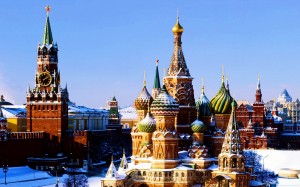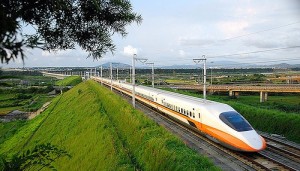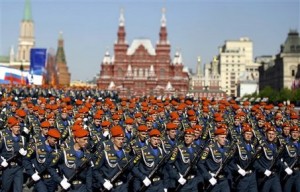 Population of Russia 2014
Population of Russia 2014
Based on the total number of births, total number of deaths, net migration rate, and the population of 2013, the current population of the Russian Federation is estimated to be about 142,590,534, which makes up about 1.98% of the world’s total population. It ranks 9th in the population rankings, behind Bangladesh, but ahead of Japan. Since Russia is a part of two continents due to its immense size, it is the sixth-most populous country in Asia, but the most populous country in Europe. At the end of 2013, the population was 142,833,689, which indicates a population decline of 243,155 or a population decay rate of 0.17%. Russia is the most populated country that is experiencing a population decline. The next largest country that is experiencing such a decline is Japan. Based on the total land area and the total population, the population density of Russia in 2014 is estimated to be about 8.34 people per square kilometer or 21.63 people per square mile.
Geography of Russia 2014
Based on the total land area, Russia is the largest country in the world, spanning 17,098,242 square kilometers or 6,592,800 square miles and spanning two continents, Europe and Asia. Geographically, most of the country is made up of plains. The plains along the northern coast are made up of tundra, but other plains in the north are made up of heavily forested areas. The southeastern borders are made up of various mountain ranges. One such mountain range is the Caucasus mountain range, which contains the highest point in all of Russia and Europe: Mount Elbrus, which reaches 5,642 meters or 18,510 feet. The volcanoes in the Kamchatka Peninsula include Klyuchevskaya Sopka, which is the highest active volcano in Europe and Asia, reaching 4,750 meters or 15,584 feet. The Ural Mountains serve as a border between Europe and Asia. Lastly, Lake Baikal is the largest body of fresh water in Russia and is also the oldest, deepest, and purest fresh water lake in the world. In fact, it contains 20% of the world’s fresh water.
Government of Russia 2014
The Constitution of Russia defines the government of Russia as a federation and semi-presidential republic. The representative democracy consists of three branches: legislative, executive, and judiciary. The legislative branch is a bicameral legislature, made up of the State Duma and the Federation Council. The Duma has 450 members and the Federation Council has 166 members. The legislative branch has the power to adopt federal law, declare war, and the power of impeachment of the President of Russia. The executive branch consists of the President, which is the head of state, the Prime Minister, which is the head of government, and the Cabinet. The current President is Vladimir Putin and the current Prime Minister is Dmitry Medvedev. The President is the Supreme Commander-in-Chief of the Armed Forces and has the ability to veto laws. The judiciary branch consists of the Constitutional Court and Supreme Court. The Federation Council appoints the justices based on the President’s recommendation. Lastly, the main political parties in the country are United Russia, the Communist Party, the Liberal Democratic Party, and A Just Russia. Both Putin and Medvedev are members of the United Russia party.
Education in Russia 2014
Education is guaranteed by the Constitution and thus is free for all Russian citizens. The Ministry of Education and Science mainly regulates the education system. During 2011, the Russian government spent $20 billion on education throughout the country. While the private option is available for those students that do not wish to use the public education system, only 1% enroll in pre-school, 0.5% enroll in elementary school, and 17% enroll in private higher education institutions. UNESCO reports that 96% of the adult population in Russia has completed lower secondary schooling. As of 2007, it is required that students attend eleven years of secondary schooling, which begins with first grade at age six. However, with parental approval, students of ages 15 through 18 have the option to drop out from school. After the ninth year, students have the ability to opt out of the normal education path and enter into a vocational training program, which helps students specialize in certain professional areas to prepare for a career. The Unified state examination is the university entrance exam for all Russian universities. Some of the most well known universities are Moscow State University and Saint Petersburg State University, both of which are considered federal universities. Lastly, as of 2008, the education system does not provide many options at all for students with mental handicaps and disabilities.
Health Care in Russia 2014
As of 1996, the Russian government mandated that everyone must have medical insurance. Thus, the Constitution now guarantees that free health care for all Russian citizens. As of 2011, the average life expectancy of adults is 69 years. For males, the life expectancy is about 63 years; for females, the life expectancy is about 75 years. There is a very high mortality rate of working-age males, which accounts for the much lower life expectancy for men. Leading causes of death are alcohol poisoning, stress, smoking, traffic accidents, and violent crimes. It is estimated that Russians drink, on average, 15 liters or 26 pints of pure alcohol every year. Also, Russia is considered the world leader in smoking. In 2011, President Putin pledged $10 billion to invest in improving health care. Part of his reform included an increase in the tax that companies must pay for medical insurance. Lastly, the under-five mortality rate, according to UNICEF, is 12 deaths per 1,000 children, and the infant mortality rate is 10 deaths per 1,000 infants.
Language in Russia 2014
The official language of Russia is Russian. However, based on a right guaranteed by the Constitution, certain regions throughout the country have adopted other languages as co-official with Russian. In fact, there are twenty-seven other languages that are co-official with Russian. Besides these co-official languages, there are over one hundred minority languages spoken in the country. Other than Russian, the most widely spoken languages are Tatar and Ukranian. But, Russian is considered the most geographically widespread language in Europe and Asia and is considered one of the six official languages of the United Nations. Lastly, of Russian citizens, 15% of the population knows a foreign language. The most prevalent foreign language is English. 78% of the speakers of a foreign language speak English, 16% speak German, 4% speak French, and 2% speak Turkish.
 Transportation in Russia 2014
Transportation in Russia 2014
The railway transportation system in Russia is controlled by the state. 3.6% of Russian Gross Domestic Product is the operation of the rails. They also control 39% of the total freight traffic and 42% of total passenger traffic. The total length of rails is over 85,500 kilometers, or 53,127 miles, which is the second in the world, next to the United States. However, Russia has the most electric rails in the world, totaling over 44,000 kilometers or 27,340 miles. As of 2006, Russia had 933,000 kilometers of total roads and 755,000 kilometers of paved roads. There are also 1,216 airports throughout the country, totaling over 600,000 kilometers or 370,000 miles of total runway length. Lastly, most major cities are considered to have quality public transportation systems. Cities like Moscow and Saint Petersburg have underground metros, which are in fact the oldest metros in Russia and are the busiest and fastest metros in the world.
Russia Population Demographic Challenge
Russia Population Projections
The population of the country is predicted to resume its population decrease, however, starting in 2015. By 2015, the population is projected to decrease to about 140.75 million people, which is a decrease of about 1.6% from the current population. Again, by 2020, the population will decrease again to about 139.31 million people, a decrease of about 2.6%. Then, by 2025, the population will reach about 137.48 million people, an approximate decrease of about 3.9%. Between 2025 and 2030, the population will decrease to about 134.82 million people, which is an approximate decrease of 5.7%. Then by 2035, the population will decrease by about 7.8% to 131.86 million. Lastly, in 2040, the population will drop below 130 million, reaching 129.14 million people, which is a decrease of 9.7% from the current Russian population. The main cause for this decrease in population is that the death rate in the Russian Federation is consistently higher than the birth rate.
Russia Demographics
Out of the approximate 143 million people in the Russian Federation, about 81% of these people identify as being of Russian nationality. About 4% of the population identifies as Tatars; about 1.4% identifies as Ukrainian; about 1.1% identifies as Bashkirs; about 1% identifies as Chuvashes; lastly, the other 11.8% is some other obscure or unspecified ethnicity. Roughly 85% of the total population is of some sort of European ethnic group, compared to the old rate of more than 86%.
Religion in Russia
The largest denomination in the Russian Federation is the Russian Orthodox Church, a denomination of Christianity. There are almost 5,000 religious associations with the Russian Orthodox Church. The second largest religion in Russia is Islam, coming in at about 19 million Muslims. There are also approximately 2 million Protestants and 1.3 million Catholics. Both Buddhism and Judaism are also fairly widespread in the country. Over 10% of the Federation’s Jewish population resides in Moscow.
Official Holidays of Russia
While in the United States, the New Year is celebrated from New Year’s Eve to New Year’s Day, in the Russian Federation, there is an official New Year’s Vacation. Starting on New Year’s Eve, the holiday is celebrated similarly to Christmas, sharing gifts, cooking meals, and having a large celebration with family and friends. However, this celebration continues through the New Year and goes until January 5. This holiday became an official Russian Holiday by Peter the Great in 1700. Some people even celebrate it twice, once on January 1 and once on January 14, the date that corresponds to January 1 before 1918 when the Julian calendar was used. The next holiday celebrated is the Orthodox Christmas, which is celebrated from on January 7th and lasts until January 19th. The next celebration is on February 23rd, the Defender of the Motherland Day. This day is a tribute to all of the Russian soldiers that have ever protected the country. March 8th celebrates International Women’s Day, which dates back to 1857 when female textile workers protested poor working conditions. The holiday has been celebrated since 1917 and is a celebration of women in Russia and all over the world.
 The next holiday is on May 1st, which is the Spring and Labor Celebration. This receives its origin from the Chicago worker strikes in 1886, demanding shorter working days. It became a holiday for the first time on May 1st, 1890. Victory Day is the most celebrated and loved holiday of Russia, remembering all of the soldiers that died in World War II. This day, Victory Day, is held on May 9th. Russia Day, June 12th, celebrates when the Declaration of the Sovereignty of the Russian Federation was accepted in 1991. Lastly, November 4th celebrates Civil Unity Day, which is the day celebrating Moscow’s liberation from the Polish armies in 1612.
The next holiday is on May 1st, which is the Spring and Labor Celebration. This receives its origin from the Chicago worker strikes in 1886, demanding shorter working days. It became a holiday for the first time on May 1st, 1890. Victory Day is the most celebrated and loved holiday of Russia, remembering all of the soldiers that died in World War II. This day, Victory Day, is held on May 9th. Russia Day, June 12th, celebrates when the Declaration of the Sovereignty of the Russian Federation was accepted in 1991. Lastly, November 4th celebrates Civil Unity Day, which is the day celebrating Moscow’s liberation from the Polish armies in 1612.


